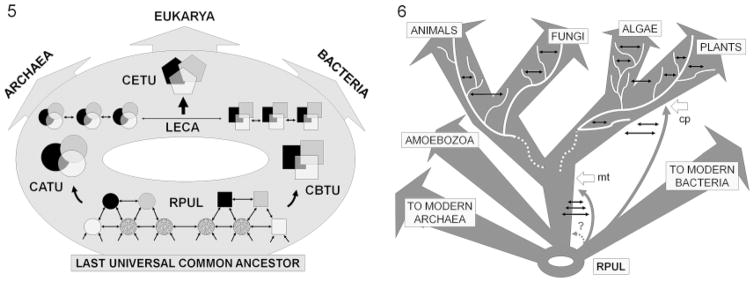Fig. 5–6.
Integrative model of lateral and vertical evolution. 5. Reticulated patterns of unicellular life (RPUL), connected by both horizontal gene transfer and common descent (arrows), emerged from a last universal common ancestor (LUCA) and diverged into clusters of archaeal (CATU, overlapping circles) or bacterial (CBTU, overlapping squares) taxonomic units; the last eukaryotic common ancestor (LECA) probably originated from symbiogenetic junction of archaeal and bacterial cells; overlapping pentagons represent clusters of eukaryotic taxonomic units (CETU); the “ring of life” depicted in the background emphasizes ongoing HGT. 6. A tree-like representation of relatedness among multicellular organisms coalesces to a RPUL, note how modern archaea and bacteria also coalesce to RPUL; “anastomosis” between eukaryotes with oxygen-breathing bacteria probably gave origin to mitochondria (mt, white arrow; a much earlier event is also possible: gray-dashed arrow with question mark on top), and between oxygen-breathing eukaryotes with photosynthetic bacteria led to chloroplast evolution (cp white arrow); hybridization (lateral exchange of genetic material via recombination) is probably more frequent in plants, algae or fungi than in animals (black horizontal arrows); a bifurcation pattern of diversification (white branching lines) is probably real among multicellular organisms because they acquire genetic material mostly via common descent. Note that only Amoebozoa are shown to account for the discussion on the origin of Entamoeba’s alcohol dehydrogenase (see text); however, other unicellular Eukaryotes—Excavata, Chromalveolata, and Rhizaria—(Andersson 2008, 2009) likely emerged from early CETU.

